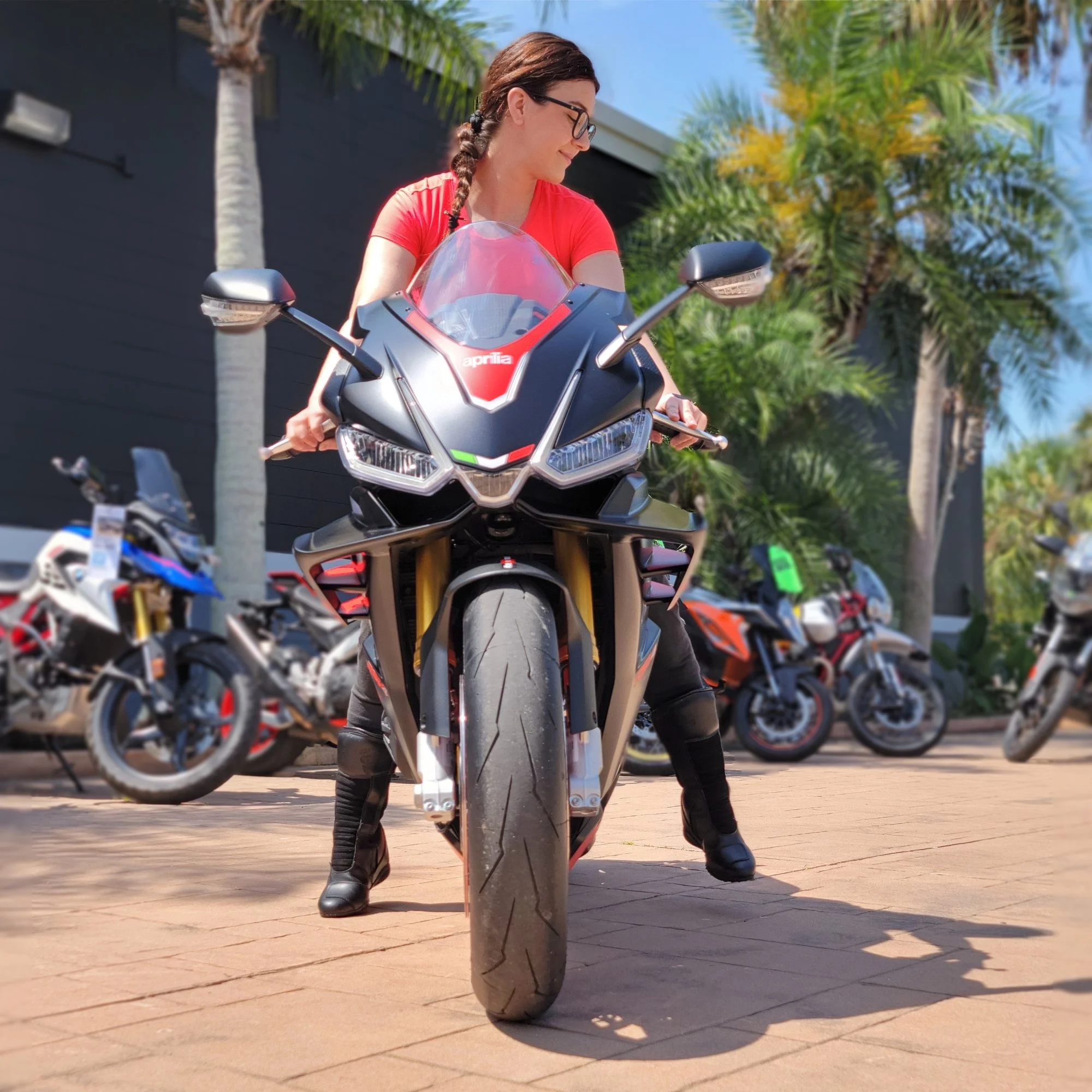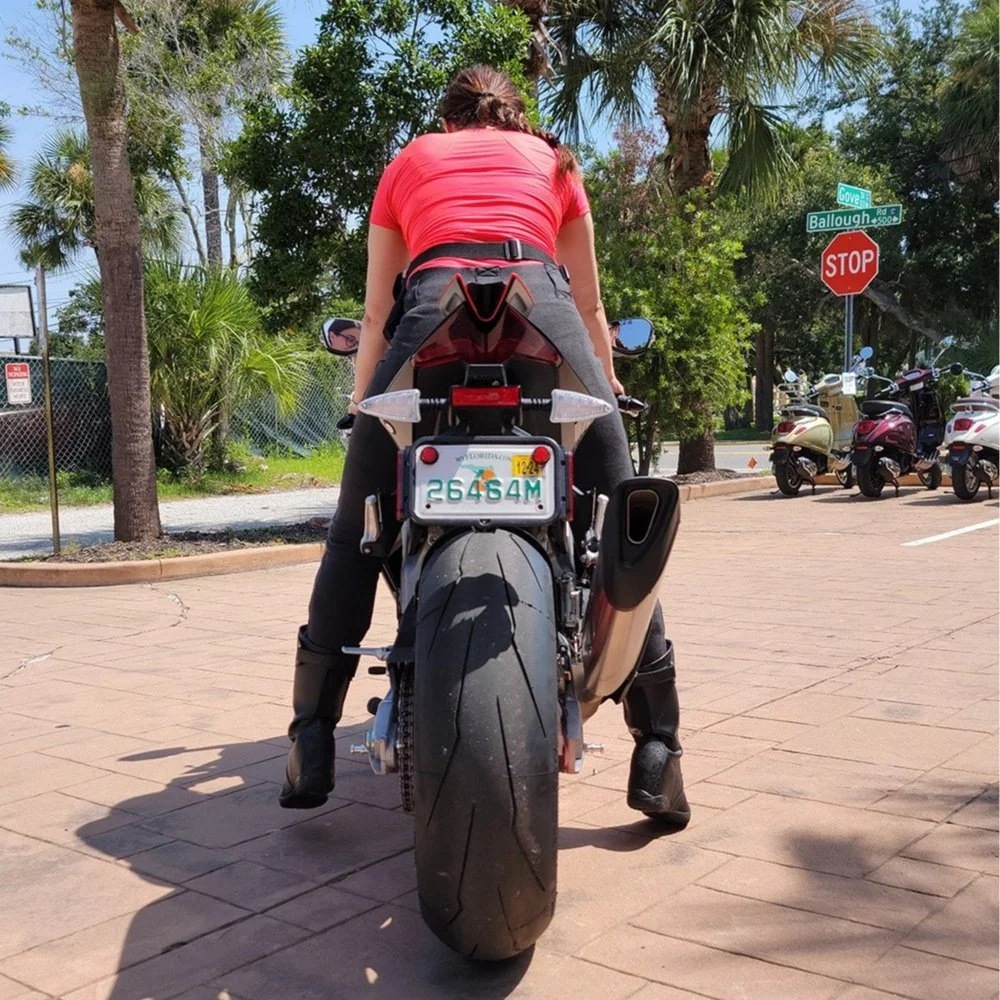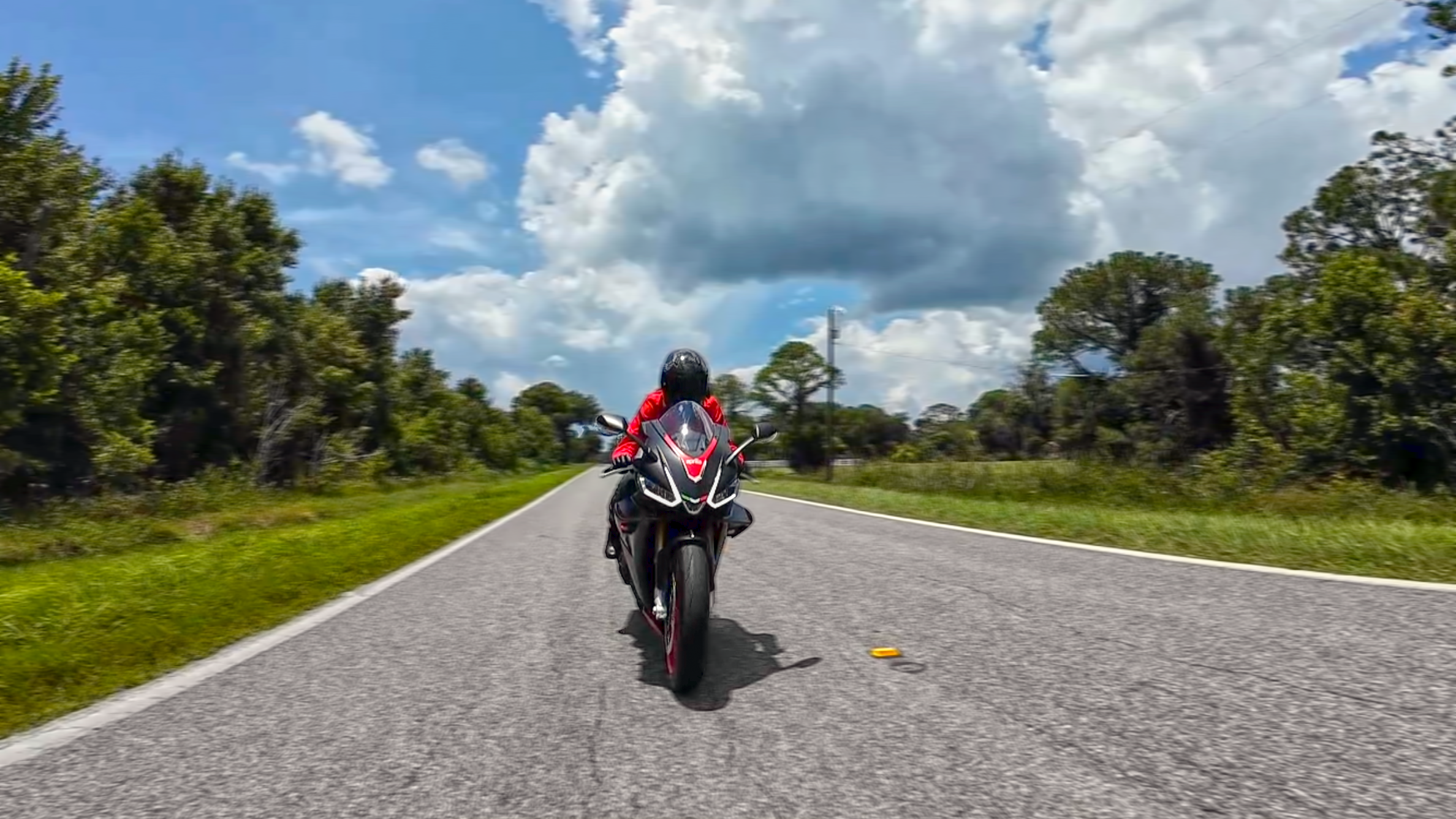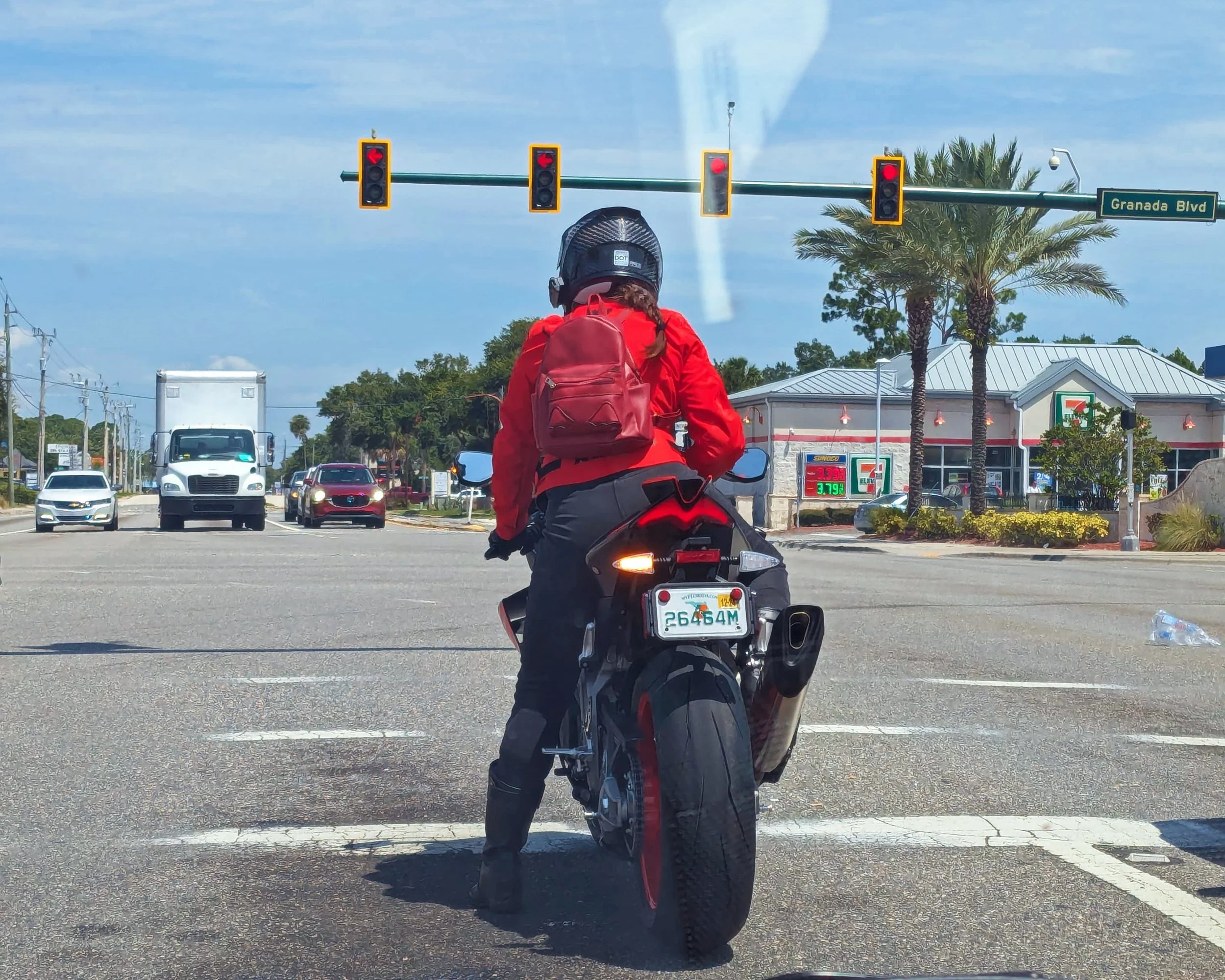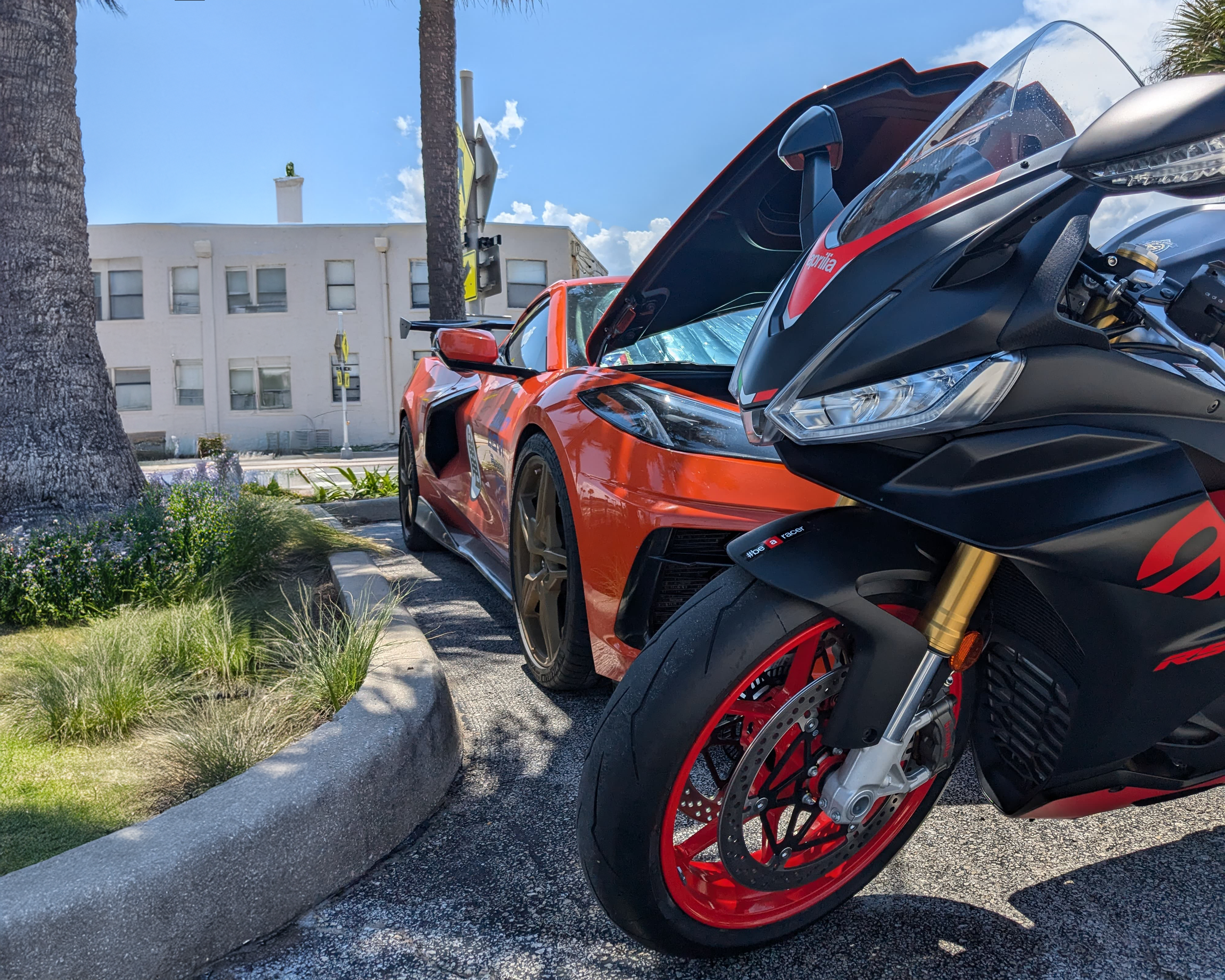Aprilia’s 2024 RSV4: a beastly tame superbike, at your discretion.
The first time I swung a leg over Aprilia’s 2024 RSV4 I found myself in sunny Daytona. I turned the key and the engine roared to life as I thought about how it has a top speed of 189 mph, 217 horsepower and 3 WSBK titles! The RSV4 also benefits from the technology of Aprilia’s RS-GP MotoGP bike. I was using it to grab some coffee and take a joy ride to the beach.
Could this powerful machine handle me: a 5 foot 4 biker girl who wears hi-viz gear in the daytime and uses her blinker amply before turning? Under that helmet I had the biggest grin on my face. I had a 3 hour route mapped out on REVER, and I was ready to replicate an average rider's experience! As I tip-toed the bike out of the parking lot in front of MotoPlex Daytona, looking like a waddling penguin, I wanted to find out how the RSV4 fared when it got a sweet taste of the mundane.
Ah, the joys of being 5’4” rider in a world of tall motorcycles. Welcome to the tip-toe gang! Photo by Lali
Rolling Out in Style in Daytona
As I rolled the RSV4 out of the parking lot, its aggressive styling immediately struck me. The full LED headlight stared into the soul of every onlooker, while the winglets and razor-thin fairings gave the bike a proper MotoGP feel. It felt almost disrespectful to ride without a full leather race suit, though I wouldn’t recommend that in this heat. The RSV4 was redesigned with one main goal: improving aerodynamic efficiency. Aprilia claims the new design better protects the rider from airflow by 11%, increases air pressure in the airbox by 7%, and boosts high-speed performance. While this means faster track times, it also makes the RSV4 more comfortable with less pressure on the shoulders and head. I briefly flashed back to commuting on a 2009 Yamaha R1, arriving with a stiff neck and lower back pain after just 20 minutes. Any design choices that made the RSV4 more street-friendly were welcome. After an hour of riding, I had no back pain or stiff neck, and thanks to cruise control and the quick shifter, my wrists felt fine—a win for Aprilia and for us riders. After two hours (with a quick stop after one), I still felt good, though my wrists, lower back, and right knee were starting to feel slightly sore. I couldn't reach the ground on both sides and favored putting my left foot down when stopping so my right knee never got a break.
The seat height is 33.3 inches. With my 29-inch inseam—even with riding boots adding an extra 2.5 inches—I could only touch the ground on one side, on my tiptoe. I had to scoot off the seat and put one foot down when stopped. Once I got over the initial anxiety of riding a tall bike, balancing on one foot became manageable, even as a shorter rider. I was still mindful of avoiding stops on uneven or sloped surfaces, which would increase the distance between my foot and the ground. The RSV4 is taller than the BMW S1000RR (32.4 inches) but slightly shorter than the Ducati Panigale V4 (33.5 inches). Ladies and short kings, I recommend boots with a hidden heel like the Joe Rocket Heartbreaker boots I wore for this review. You can find them here at RevZilla.
My inseam is about 29 inches (31.5 inches with these riding boots) which is still too short for the RSV4’s 33.3 inch seat height. Though I praise Aprilia for not putting the foot pegs where my foot would naturally want to come down. Photo by Lali
Engine and Performance
While cruising along a back road at 60 mph, I came to a perfectly straight stretch with no traffic in sight. What a perfect time for a quick pull, I thought! I went full tuck and twisted the throttle. The exhaust note was beautiful, and the wind resistance was non-existent as I sped up to what felt like 80 mph. I looked down at the dash: 127 mph. Whoa! What? That was so buttery smooth! How did I get up to triple digits so fast? The 65° high performance V4 engine puts out 217 horsepower at 13,000 rpm. In full tuck, the RSV4 made me feel like the world around me was slowing down—probably dangerous on the road, but immensely useful at the track, I would imagine.
The power delivery in road mode is pretty smooth and consistent in lower rpms. As the revs increased I kept getting that same buttery smooth feeling. It didn’t feel lacking at any point up to 70 mph, a range I think most road-users would be paying attention to. The throttle response is immediate at any rpm, there’s no lag or hesitation that I could feel.
The acceleration is buttery smooth and the exhaust sounds great anytime you open the throttle! Photo by Lali
The RSV4 offers 6 riding modes, 3 for the track and 3 for the road. The road mode limits the 1099cc engine to 140 horsepower. This half 'n half design suggests it's a beastly tame superbike—if you want it to be. For this review, I kept it in the "Street" mode of the road option. However, even in road mode, I could customize the engine map, traction control, wheelie control, ABS, launch control, and engine braking, turning this ride from a relaxed coffee run into a Starbucks superbike sprint race.
Street mode is fast enough for normal riding, and while there isn't a dedicated "Rain" mode, there’s a fully customizable setup called "User." With so many personalized settings, Aprilia missed an opportunity to let riders name the "User" mode. You could have "Sport," "Street," and a sensible "Don't worry, dear" mode…for the rain, of course.
Surprisingly, this beast built for speed idled peacefully among sedans and SUVs. The exhaust note was quiet at red lights. I wondered if the sound would impress at 70 mph or if I'd just get wind noise. Sadly, at 4500 rpm in 6th going 70 mph, I mostly heard wind noise. The exhaust produces a calm growl while cruising but transforms into a refined roar with a quick twist of the wrist. I understand why riders often replace the exhaust on a new motorcycle, but here, I think it’s lower on the list of mod priorities. Though the exhaust is 'quiet' in the regulation sense, it sounds great during acceleration and when revving under a bridge— free concert for everybody!
I’m short, but balancing the bike at a stoplight came naturally after a few lights. Despite being 465 lbs, the RSV4 feels deceptively light. However, my foot was getting a proper dark roast from the engine heat. Photo by Lali
Display and Handlebar Controls
I had plenty of time to admire the new 5" TFT instrument panel while tip-toeing at red lights. The screen displays everything you need to know, with new graphics and two modes, one for the street and one for the track. It feels less like a speedometer and gear indicator, and more like a pilot's cockpit, which isn't far off considering the RSV4's top speed is 189 mph and a standard Airbus takes off at 170 mph. It's a lot of information to take in at once. I wondered how easy it was to switch the display graphics with gloves on and found the handlebar controls intuitive and fairly easy for my small hands. The only button I had trouble reaching was the mode change button on the right handlebar. It's tucked under the engine start/stop button, and I couldn't reach it without letting go of the throttle. Maybe this was by design since I had to roll off the throttle and back on to lock in a new riding mode once I selected it.
There’s so many acronyms and info to take in on the display, such as ATC: that must be short for “air traffic control” because this feels like a pilot’s cockpit. Photo by Lali
Quick Shifter
One consolation about stop-and-go traffic is using the bi-directional quick shifter and hearing it in action. After the 5th red light, my left hand welcomed the break. I used the quick shifter around 3000-5000 rpm and found the shifts swift and smoother than nitro cold-brew. The exception was quick-shifting out of first. No matter the rpm, it felt clunky going into second—more like tepid, leftover drip coffee with grounds at the bottom. The rest of the gears were smooth sailing.
Handling and Maneuverability
While navigating city streets, the RSV4’s low-speed handling came into focus. On an empty road, I swerved to test its flickability. Verdict: It's mid—not as nimble as middle-weight bikes, but not an immovable object either. At 465 lbs, it’s heavier than its competitors, the BMW S1000RR (443 lbs) and Ducati Panigale V4 (431 lbs), but didn’t feel heavy as I swerved in my lane. It moved all 465 lbs responsively from side to side. That said, I don't feel a burning desire to practice slow maneuverability on the RSV4, and I doubt it would enjoy that either. Despite being 5'4" and unable to touch the ground on both sides, I didn’t find the bike heavy. I simply stepped off to maneuver it around tight spaces in a parking lot, which was surprisingly easy.
The RSV4 can hold its own in the speed and looks department. Feel free to bring it to any car meet and revel in the fact that you have the fastest machine on the lot. Not that anyone is keeping score... Photo by Lali
Final Thoughts
So, should you buy an Aprilia RSV4 as a daily bike? Well, I can't tell you how to live your life, but I was pleasantly surprised by the comfort I experienced on a superbike. My back, neck, and wrists wouldn't dread commuting on it. However, passenger comfort is a different story, as the pillion seat is hard to spot without using a microscope. I think you can ride the RSV4 sensibly if you want to. Unless you're a racer or aspiring to be a racer, opt for the RSV4 instead of the RSV4 Factory and save yourself $7000, unless you have a dire need for electronically managed suspension and aluminum forged wheels.
If a track focused review is what you’re looking for check out Ari Henning's first ride review article here. He documented his riding experience with the RSV4 1100 Factory on the famous Mugello MotoGP circuit.
Confirmed: I got my cup of joe and rode the RSV4 like an average Joe. It’s possible!
In the end, I rode it to Daytona Beach, spent a few minutes listening to the ocean waves in a park while sipping my coffee, and then rode the last few minutes in the rain back to the dealership. It was a nice, average day of riding—exactly what I was hoping for.


